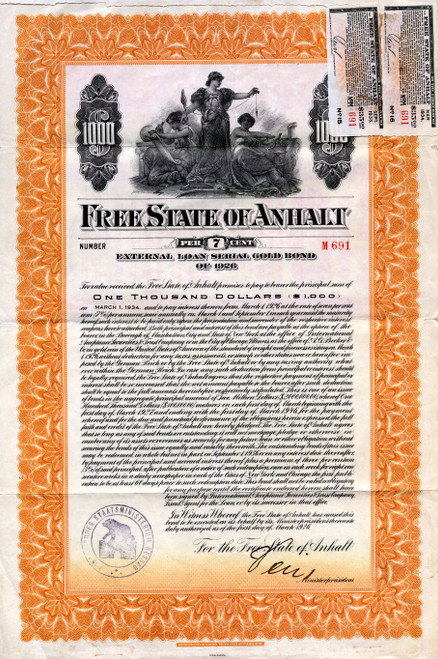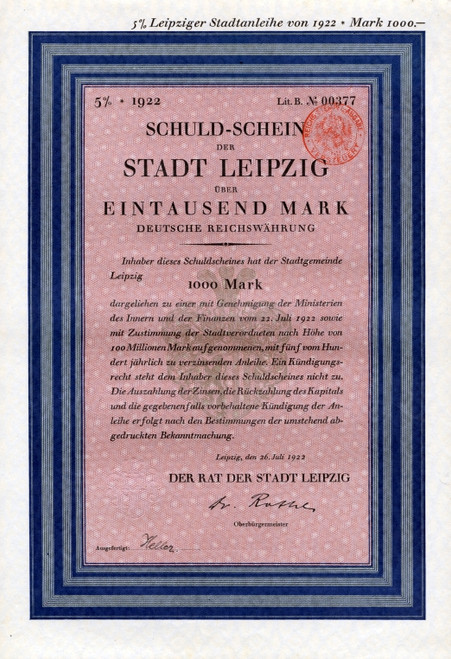Beautiful £100 Bond certificate from the Free State of Saxony issued in 1927. This historic document was printed by Bradbury, Wilkinson & Company and has an ornate border around it with a vignette of a female with wheat sheaf. This item has the signatures of the Minister of Finance, the Official of the Administration for the National Debt, and an Administrator and is over 91 years old. 
Certificate Vignette The Free State of Saxony (German: Freistaat Sachsen; Sorbian: Swobodny Stat Sakska) is the easternmost federal state of Germany. Located in the country's southeast, it is the tenth-largest in area and sixth-largest in population among Germany's sixteen states, and has a land area of 18,413 km² and a population of 4.3 million. Saxony has a long history as a duchy, an electorate (the Electorate of Saxony), and eventually as a kingdom (the Kingdom of Saxony). Its monarchy was overthrown in 1918 and a republican form of government was established under its current name subsequent to Germany's defeat in World War I. Abolished during communist rule, it was re-established in 1990 after the re-unification of the nation-state of Germany from East and West Germany. During the early Middle Ages the term Saxony referred to the region occupied by today's states of Lower Saxony and northern North Rhine-Westphalia. The Saxons had migrated there from the area of present-day Schleswig-Holstein between 250 and 500. See the history section below. Saxony cannot necessarily correlate with every other meaning of "Saxons"; that is, a Saxon is not necessarily an inhabitant of Saxony (e.g. Saxon people, Anglo-Saxons or Transylvanian Saxons). For full disambiguation of the meaning, see Saxon (disambiguation). Saxony shares borders with, from the east and clockwise, Poland, the Czech Republic and the German states of Bavaria, Thuringia, Saxony-Anhalt and Brandenburg. Its capital is Dresden, and the other principal cities are Leipzig and Chemnitz. The main axis of Saxony is the Elbe river, crossing the state from southeast to northwest. Another important river, west of the Elbe, is the Mulde. The Lusatian Neisse river forms the Polish border. The portions in the east of Saxony are the southern parts of the historical region of Lusatia (Lausitz) and are called Upper Lusatia (Oberlausitz); the minority Sorbs live in the region, which is partially (for example around Bautzen, Hoyerswerda and Kamenz but not around Zittau and Görlitz) bilingual today. The countryside rises gradually from north to south, culminating in the mountain ranges along the Czech border. The Ore Mountains (Erzgebirge) extend from Bavaria to the Elbe river. The Elbe itself has cut a majestic gorge to pass the mountains of the Elbsandsteingebirge, better known as Saxon Switzerland. Further east the mountains are less high and form a hilly countryside called the Lausitzer Bergland. See also List of places in Saxony. History from Wikipedia and OldCompanyResearch.com.

Certificate Vignette














